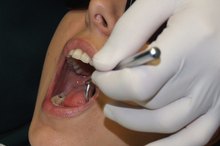Signs of Lip Cancer
Lip cancer is the most common type of cancer that affects the mouth. This disease occurs most frequently in people who use tobacco or spend a lot of time in the sun, without using lip protection. If recognized early, the cure rate for lip cancer can be as high as 90 percent. See you doctor right away if you have symptoms of lip cancer.
Irritation
Lip cancer usually begins in the squamous cells--thin flat skin cells--and spreads into deeper areas of the lips as the cancer grows. An early sign may be an irritated area that looks like chapped lips. Patients who smoke, use alcohol, use mouthwash containing alcohol or who are exposed to sunlight for prolonged periods of time should be particularly suspicious of an irritated area on the upper or lower lip.
Sore
Early Signs of Squamous Cell Mouth Cancer
Learn More
A sore on the lip that does not heal after one to two weeks may be an early sign of cancer. The sore may be numb or painful, may bleed easily or excessively, or may appear as crusty patches on the lip. Individuals should examine their mouths and lips for unusual-appearing lesions every month and report these symptoms to their health care providers.
Lump
A lump or thickening on the lip that does not go away after one to two weeks should be examined by your doctor. The lump or thickening may be numb or painful. Benign or nonmalignant tumors may have a similar appearance -- biopsy or other testing may be required to make the diagnosis.
Pain or Numbness
Diseases and Disorders of the Tongue
Learn More
Lip cancer may first appear as pain or numbness on the lip without any visible signs of a tumor. Pain elsewhere in the oral cavity, including the jaw, gums, lining of the mouth or tongue, may be a sign that the lip cancer has spread 2. Pain and swelling in the lymph nodes of the jaw or neck is a serious indication of metastasis or spread of the cancer. As a general rule, lip cancer that has spread to the lymph nodes or nearby structures is considered stage III or stage IV, depending on the extent of metastasis. These advanced stages require more invasive treatment than stages I and II, which do not involve other structures of the head or neck.
- Lip cancer may first appear as pain or numbness on the lip without any visible signs of a tumor.
- Pain and swelling in the lymph nodes of the jaw or neck is a serious indication of metastasis or spread of the cancer.
Related Articles
References
- Acta Otorhinolaryngologica Italica: Surgical Management of Lip Cancer
- Cleveland Clinic: Lip and Oral Cavity Cancer
- Medicina Oral Patologia Oral y Cirugia Bucal: Upper lip malignant neoplasms. A Study of 59 Cases
- Kaunitz AM. Patient education: Abnormal uterine bleeding (Beyond the Basics). UpToDate. Updated January 14, 2019.
- Baicus C, Rimbas M, Baicus A, Caraiola S. Cancer and involuntary weight loss: failure to validate a prediction score. PLoS ONE. 2014;9(4):e95286. doi:10.1371/journal.pone.0095286
- InformedHealth.org. Colorectal cancer: Overview. Cologne, Germany: Institute for Quality and Efficiency in Health Care (IQWiG). Updated April 5, 2018.
- Porporato PE. Understanding cachexia as a cancer metabolism syndrome. Oncogenesis. 2016;5:e200. doi:10.1038/oncsis.2016.3
- American Cancer Society. Limitations of Mammograms. Updated October 9, 2017.
- American Cancer Society. Signs and Symptoms of Hodgkin Lymphoma. Updated May 1, 2018.
- Sathyanarayan V, Bharani SK. Enlarged lymph nodes in head and neck cancer: Analysis with triplex ultrasonography. Ann Maxillofac Surg. 2013;3(1):35-9. doi:10.4103/2231-0746.110077
- Howell DA, Warburton F, Ramirez AJ, Roman E, Smith AG, Forbes LJ. Risk factors and time to symptomatic presentation in leukaemia, lymphoma and myeloma. Br J Cancer. 2015;113(7):1114-20. doi:10.1038/bjc.2015.311
- Kaunitz AM. Patient education: Abnormal uterine bleeding (Beyond the Basics). Updated January 14, 2019.
- Lakatos PL, Lakatos L. Risk for colorectal cancer in ulcerative colitis: changes, causes and management strategies. World J Gastroenterol. 2008;14(25):3937-47. doi:10.3748/wjg.14.3937
- Molassiotis A, Smith JA, Mazzone P, Blackhall F, Irwin RS. Symptomatic Treatment of Cough Among Adult Patients With Lung Cancer: CHEST Guideline and Expert Panel Report. Chest. 2017;151(4):861-874. doi:10.1016/j.chest.2016.12.028
- American Cancer Society. Signs and Symptoms of Lung Cancer. Updated February 22, 2016.
- American Cancer Society. Signs and Symptoms of Adult Brain and Spinal Cord Tumors. Updated November 6, 2017.
- Owonikoko TK, Arbiser J, Zelnak A, et al. Current approaches to the treatment of metastatic brain tumours. Nat Rev Clin Oncol. 2014;11(4):203-22. doi:10.1038/nrclinonc.2014.25
- Mabry LM, Ross MD, Tonarelli JM. Metastatic cancer mimicking mechanical low back pain: a case report. J Man Manip Ther. 2014;22(3):162-9. doi:10.1179/2042618613Y.0000000056
- Narayanan V, Koshy C. Fatigue in cancer: a review of literature. Indian J Palliat Care. 2009;15(1):19-25. doi:10.4103/0973-1075.53507
- Office of the Surgeon General. U.S. Department of Health & Human Services. Surgeon General Call to Action to Prevent Skin Cancer: Exec Summary. Updated July 28, 2014.
- Jelovac D, Armstrong DK. Recent progress in the diagnosis and treatment of ovarian cancer. CA Cancer J Clin. 2011;61(3):183-203. doi:10.3322/caac.20113
- Freedman ND, Silverman DT, Hollenbeck AR, Schatzkin A, Abnet CC. Association between smoking and risk of bladder cancer among men and women. JAMA. 2011;306(7):737-45. doi:10.1001/jama.2011.1142
- Ramakrishnaiah VP, Malage S, Sreenath GS, Kotlapati S, Cyriac S. Palliation of Dysphagia in Carcinoma Esophagus. Clin Med Insights Gastroenterol. 2016;9:11-23. doi:10.4137/CGast.S30303
- Elyamany G, Alzahrani AM, Bukhary E. Cancer-associated thrombosis: an overview. Clin Med Insights Oncol. 2014;8:129-37. doi:10.4137/CMO.S18991
- Kenner BJ. Early Detection of Pancreatic Cancer: The Role of Depression and Anxiety as a Precursor for Disease. Pancreas. 2018;47(4):363-367. doi:10.1097/MPA.0000000000001024
- Prabhu SR, Wilson DF. Human papillomavirus and oral disease - emerging evidence: a review. Aust Dent J. 2013;58(1):2-10. doi:10.1111/adj.12020
- Goldner W. Cancer-Related Hypercalcemia. J Oncol Pract. 2016;12(5):426-32. doi:10.1200/JOP.2016.011155
- Hershey DS, Hession S. Chemotherapy and Glycemic Control in Patients with Type 2 Diabetes and Cancer: A Comparative Case Analysis. Asia Pac J Oncol Nurs. 2017;4(3):224-232. doi:10.4103/apjon.apjon_22_17
- Hamilton W, Walter FM, Rubin G, Neal RD. Improving early diagnosis of symptomatic cancer. Nat Rev Clin Oncol. 2016;13(12):740-749. doi:10.1038/nrclinonc.2016.109
- American Cancer Society. Cancer Prevention and Early Detection Facts and Figures.
- Hamilton W, Walter F, Rubin G, Neal R. Improving Early Diagnosis of Symptomatic Cancer. Nature Reviews: Clinical Oncology. 2016 Jul 26. (Epub ahead of print).
- Søgaard M, Thomsen RW, Bossen KS, Sørensen HT, Nørgaard M. The Impact of Comorbidity on Cancer Survival: a Review. Clin Epidemiol. 2013;5(Suppl 1):3–29. Published 2013 Nov 1. doi:10.2147/CLEP.S47150
- Walter F, Emery J, Mendonca S, et al. Symptoms and Patient Factors Associated with Longer Time to Diagnosis for Colorectal Cancer: Results From a Prospective Cohort Study. British Journal of Cancer. 2016 Aug 4. doi:10.1038%2Fbjc.2016.221
- Zeichner S, Montero A. Detecting Cancer: Pearls for the Primary Care Physician. Cleveland Clinic Journal of Medicine. 2016. 83(7):515-23. doi:10.3949/ccjm.83a.15124
Writer Bio
Marcy Brinkley has been writing professionally since 2007. Her work has appeared in "Chicken Soup for the Soul," "Texas Health Law Reporter" and the "State Bar of Texas Health Law Section Report." Her degrees include a Bachelor of Science in Nursing; a Master of Business Administration; and a Doctor of Jurisprudence.









